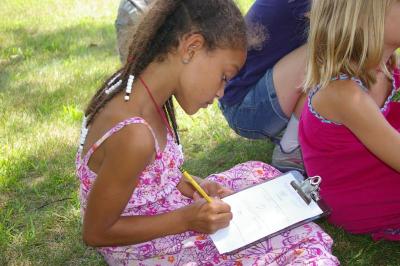Wareham students discover nature with the Buzzards Bay Coalition


Ty Counts thought it looked slimy.
Morgan Gifford warned: "It'll pee in your hands, so watch out!"
Margo Connolly, senior educator with the Buzzards Bay Coalition, added, "They can actually breathe through their skin a little bit."
Maverick Cavacas announced to everybody just what it was: "We have a special guest here today, and his name is Mr. Frog!"
Counts, Gifford, and Cavacas, all soon-to-be third graders at Wareham's elementary schools, were participating in a Buzzards Bay Coalition educational program nestled within the summer CARE program at the Wareham Middle School.
The CARE program, which stands for "Community, Academic, Recreation, and Enrichment," is a six-week program that helps elementary and middle school students sharpen their classroom skills over the summer.
Approximately 30% to 40% of CARE students are special-education students, and more than 60% of students are considered low-income, according to CARE program organizer Jane Fondulis.
The Buzzards Bay Coalition conducted classes throughout the summer to help students experience and appreciate nature. The hope is that the students will turn into future stewards of the environment, said Connolly.
"Before you can protect something, you need to know it. And before you know it, you need to love it," said Connolly, noting that she was paraphrasing a well-known quote.
Monday, August 6, was the last week of the program, and students ventured out into nature for their final project.
"I'm a fan of … using all your senses to experience something," said Connolly. "Getting your own observations of it is more memorable than any fact you'll read in a book."
The nature walk proceeded around Wareham Middle School and the Boys & Girls Club, and ended at the track and field complex across from the middle school.
The students were first tasked with finding objects of nature that fit various shapes.
Cavacas, trailing behind the rest of the group as he lingered with newly-found specimens, found a flower that looked like a circle, a leaf that looked like a heart, and another flower that looked like a star.
The students then discovered a way to take pictures of their observations without using a camera.
Sitting under the shade of a tree with clipboard and crayon in hand, the students placed a leaf on the clipboard and a white paper over the leaf. They then colored the white paper over the leaf, and watched as an imprint of the leaf appeared.
"If you go out into nature … you could just take it and do that and show somebody," explained Gifford about the usefulness of the technique. "Then they could say, 'Oh! That's an oak leaf, did you know that?'"
Next stop on their trip was a hidden pond tucked in next to the track and field complex.
In addition to long blades of grass and tadpoles, the pond also had objects which did not belong in it.
"What's wrong with this pond?" asked Connolly, and someone answered: "It has trash in it."
With buckets and net in hand, Connolly went to the border of the pond and took all of one minute to discover three tadpoles the size of a child's hand (Connolly later added that they were probably soon-to-be bullfrogs).
"Oooooh," chorused the students as they crowded around to peer into the buckets at the tadpoles.
"Eeeeeew," was the reaction of Minot Forest Elementary student Heather Cormier.
A frog was later added to the mix, prompting even more reaction from the students.
"Make sure it doesn't hop!" said one student.
"Let's vote on what we can name it," added Brendan Cavacas.
It's those type of reactions that the Buzzards Bay Coalition hopes will create memorable experiences for the students and turn them into nature-lovers.
And the young students seem to be up for it.
"Maybe we could do a fundraiser to help us clean up the pond," Cavacas suggested as he said goodbye to the pond and made his way back to the middle school.


















